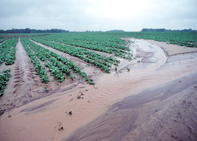
Macro-Catchment
Rainwater is collected from runoff areas surrounding the farm or plot. Water can be slowed down and channelled into terraces, such as the jessours used in Tunisia. These terraces are found in steeply sloped areas where annual rainfall is between 100 - 200 mm.
Accumulating rainwater can increase the available water to equivalent the of 400 - 500 mm of rainfall per year. Stone walls that form shallow basins or dams and a slipway to release excess water are features of macro-catchment systems. Any excess water can be stored. Other advantages include recharging of groundwater and flood control.
Micro-Catchment

Rooftop Micro-Catchment
Rainwater is collected from a roof and channelled via gutters or pipes into a storage tank. A tap is normally connected to the tank. Water is immediately available for domestic use.The Best Rainwater Harvesting Technique
The in-field rainwater harvesting (IRWH) technique was developed by researchers of the Agricultural Research Council’s Institute for Soil, Climate and Water in Bloemfontein.
The IRWH technique consists of 2 m-wide strips between alternate crop rows and storing the runoff water in the basins or small shallow dams. After the basins have been constructed, no cultivation and no tilling - ploughing and loosening of the soil - is done on the runoff area and a crust then forms, which enhances water runoff.
Water collected this way can infiltrate deep into the soil below the surface layer, therefore reducing evaporation. This rainwater harvesting technique combines the agricultural practices of water harvesting, no-till, basin tillage and mulching on drought-risk clay soils. Basin tillage means that the soil in the area where the water is collected, for example shallow dams, are loosened.
This can be done with a rake and will ensure that the water is easily absorbed into the soil. The IRWH technique can reduce total water runoff to zero and also reduces evaporation from the soil surface. This results in increased yields due to more water in the plants’ root zone.
Research at Thaba Nchu in the Free State Province found the IRWH technique increased the yield of summer crops: maize increased by 40%, sunflower by 30% and dry beans by 90%. It is recommended to apply mulch to the runoff area to prevent soil moving away with the water.
Advantages of In-Field Rainwater Harvesting
Advantages of the basin area:
Stops in-field runoff.
Maximizes water infiltration.
Stores harvested water in the soil profile.
Applying of mulches in basins minimizes evaporation.
Advantages of the runoff area:
Promotes in-field water runoff.
Acts as a secondary water storage facility.
Application of mulches on the runoff area minimizes evaporation and prevents soil erosion.
Requirements of In-Field Rainwater Harvesting - IRWH
In-field rainwater harvesting is not suitable on sandy soil and is best used on clay soils or duplex soils - soils of contrasting layers with clay content.
To determine the clay content, roll a piece of soil in a worm shape and try to fold it into a C. The slope should not exceed 8% on non-erodable soils, such as rock and annual rainfall must be between 450 and 700 mm.
Source Water Research Commission